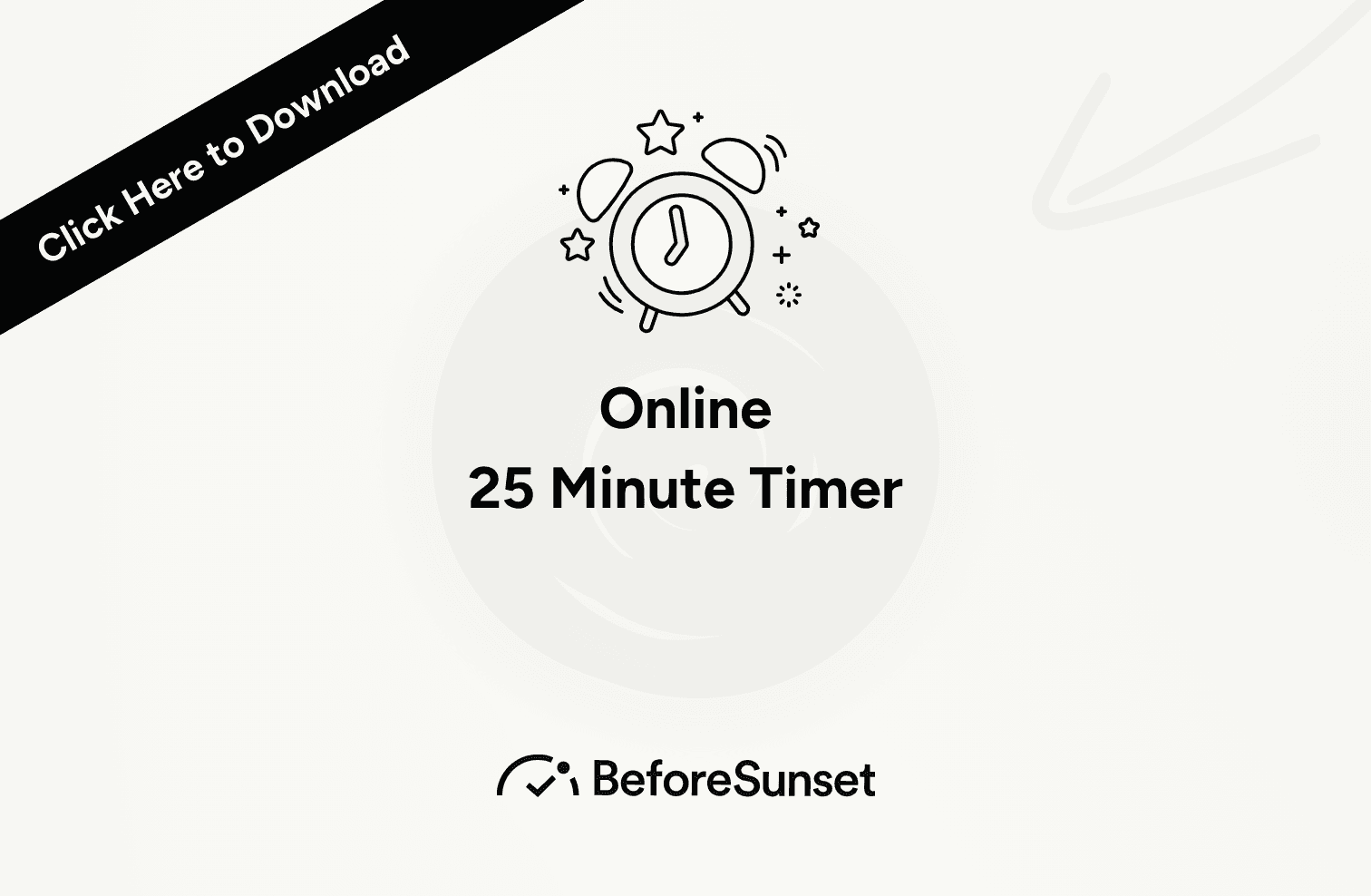Did you know that reaching productivity is as easy as using an online timer called 25 minute timer? In today’s competitive and all-demanding landscape, productivity is king. And time management is the biggest tool we can utilize to help guide us or lead us to our most efficient output.
After all, using our time better and more efficiently means getting more done in the same amount of time, right? The time we have is not refundable or exchangeable; so we need to learn to use it with intention.
At BeforeSunset, we strive to help you finish your workday, well, before sunset! But with over half of the participants in our work-life balance survey working over 40 hours weekly, it’s evident that throwing more hours in the fire seems to be our go-to method for completing all our tasks.
But what if we told you that there was a way to get the same work done in a much shorter time? Sounds like you are ready to find out.
Before we dive in, I am incredibly excited to announce our Focus Mode feature with you. Did you know that with Focus Mode you can generate backgrounds with AI while using the pomodoro technique, AI can plan your tasks, make them actionable and generate subtasks, integrate your spotify and listen to your study music! You will love this feature!
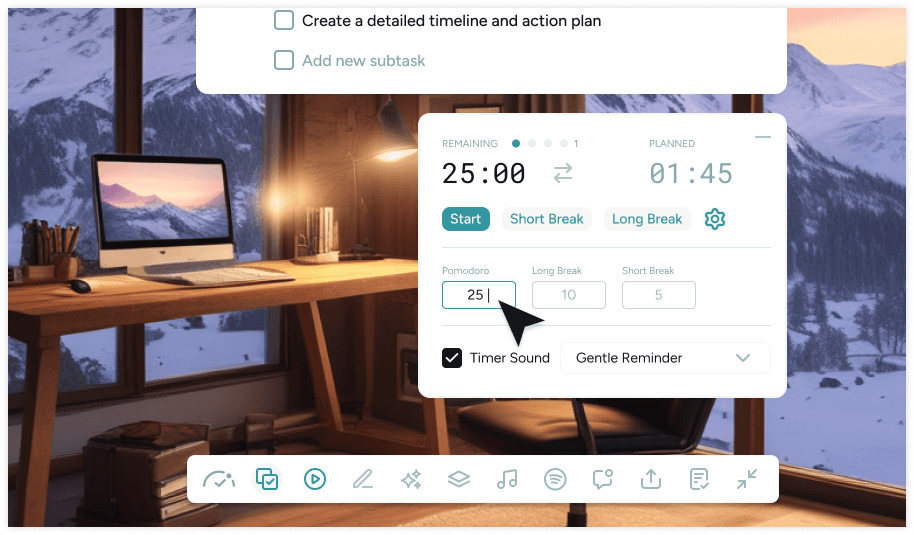
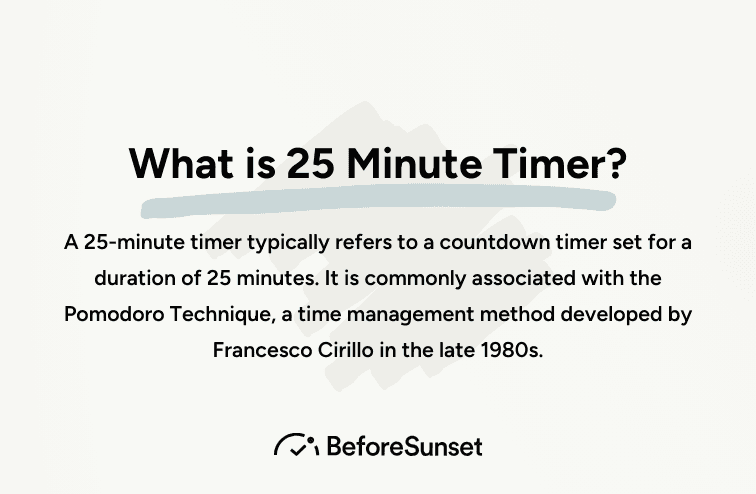
What is 25 Minute Timer?: The Pomodoro Technique
The 25 minute timer technique is a productivity method where the person sets themselves up with a specific amount of time to work on something, usually between 5 and 7 hours. The Pomodoro technique has been proven to increase productivity by 50% in just 4 weeks.
The 25 minute timer method is a time management technique. It helps you focus on the important tasks that are due in your day rather than wasting time ruminating over small issues. It is one of the great study habits. Just like a supplement to help you focus.
Also, the 25 minute timer method is a time management strategy that helps you organize your day and achieve your goals. It’s all about setting a timer for 25 00 minutes, working on the task or project you have set for yourself during that countdown, and then rewarding yourself with a 5 minute break.
Uncovering The Origin of the 25-Minute Timer
What does a tomato have to do with time management you may ask, well it all started when a student named Francesco Cirillo needed a new way of working for his overwhelming schedule.
A Pomodoro History
The date was the 1980s and he was Italian so he had a tomato shaped kitchen timer/watch and he decided to use it to track his time. At first, it was just for 10 minutes then he perfected his technique by deciding on setting a timer for 25 minutes and taking 5 minute breaks.
He then moved on to writing a 130 page long book about this simple technique. His efforts to increase productivity and decrease anxiety become a success story.
Approximately over 2 million people are using this technique to focus on the work they are doing. You can be one of them, all you have to do is to scroll up on this page and start the timer.
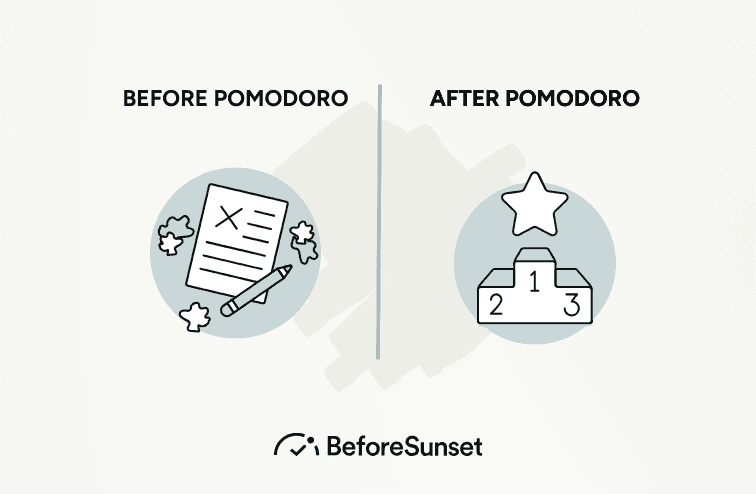
Why is Tomato Pomodoro?
The Italian word "pomodoro" literally means "tomato," which is the English equivalent. In addition, the "Pomodoro" technique for managing time makes reference to this technique. Created by Francesco Cirillo in the late 1980s, the name comes from the tomato-shaped kitchen timer he used at the time.
The tomato-shaped countdown timer that Cirillo used to keep track of his breaks inspired the name "Pomodoro." First, he used the timer in the kitchen, but later, he found that it could also be put to good use at the office. The tomato symbol is now widely used to signify the Pomodoro Method as the countdown timer.
Wonders of Time Management
Time management can make all the difference when it comes to boosting productivity. It is no wonder Paul J. Meyer once said:
“Productivity is never an accident. It is always the result of a commitment to excellence, intelligent planning, and focused effort.”
So, there are two ways to go about how we approach the time we have on our hands: we either let time run us, or we take the strings and we run it in our favor. Taking the strings requires leadership and agency in terms of what direction you will pull the time that is accessible to you.
That is where time management strategies come in to help set you up for maximum productivity, but not at your own expense…
Recording how much time is spent on each task throughout the day can help increase productivity by revealing which tasks waste the most time. These can be: responding to unnecessary emails, getting distracted too often, attending too many meetings, and a plethora of other distractors keeping you from focusing on what’s important.
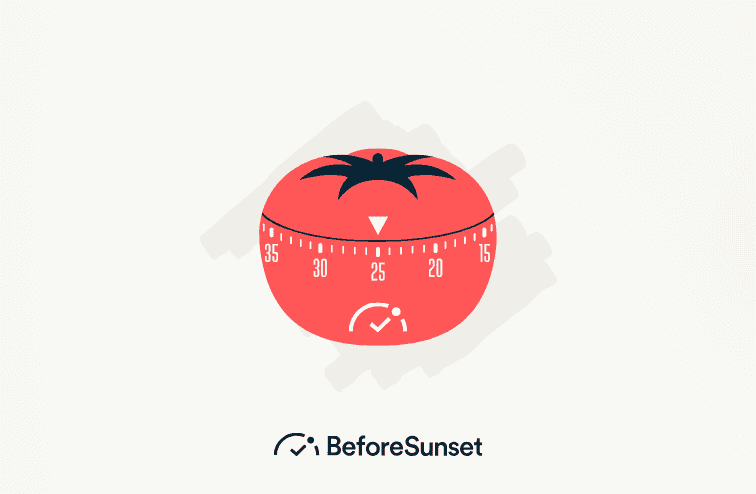
Knowing which activities are eating up your time can help you optimize your hours to make the most of your working day.
Some time-tracking tools help with this streamlining process as well; for example, BeforeSunset analyses how your time is spent each day and looks for patterns of time consumption that can be improved. Then, based on your data, it gives actionable insights to let you know precisely how you can streamline time-consuming activities.
But What’s The Best Way to Use a Productivity Software?
Not to brag but the best way to use a productivity softwareis through BeforeSunset. We have the simplest time tracking feature where you can see how much time you spent on individual projects or tasks. The best part is, it can be used by anyone. You can be an hourly employee or a part timer If what you need is to be productive BeforeSunset got you covered.
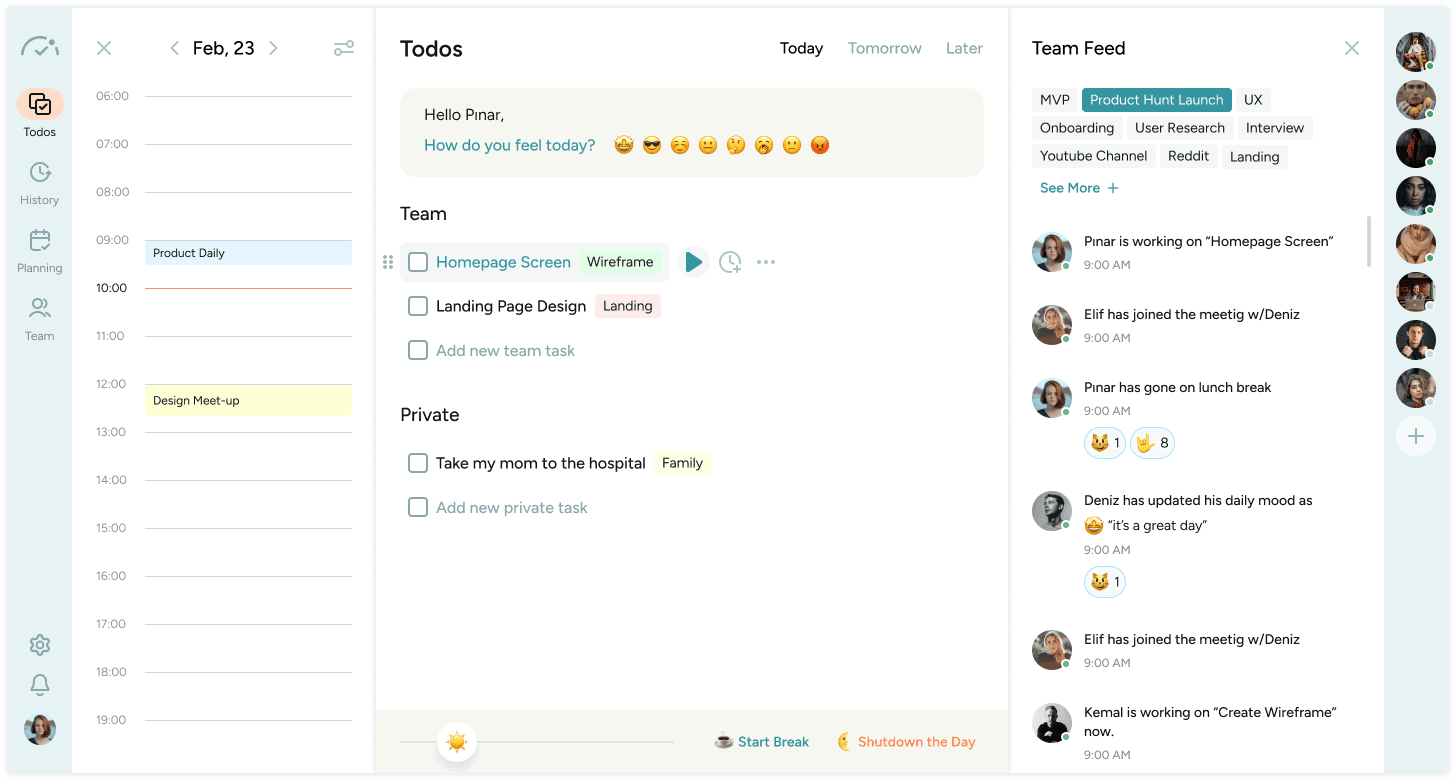
Here Comes The 25 Minute Timer Technique
The 25 minute timer technique, also known as the Pomodoro technique, is one of the most popular time management methods used by professionals and works wonders for millions of hourly workers worldwide to improve work efficiency and productivity.
The main idea is to increase your mental agility and productivity by working in short bursts of time and giving yourself frequent rest periods. By using this method, you can plan, undertake, and review tasks much more effectively and save hundreds of hours of extra work.
The technique is effortless, and you need a countdown timer to implement it into your work routine. It works by dividing your working hours into 25 00 minute intervals, with short rest periods in between to revitalize your focus.
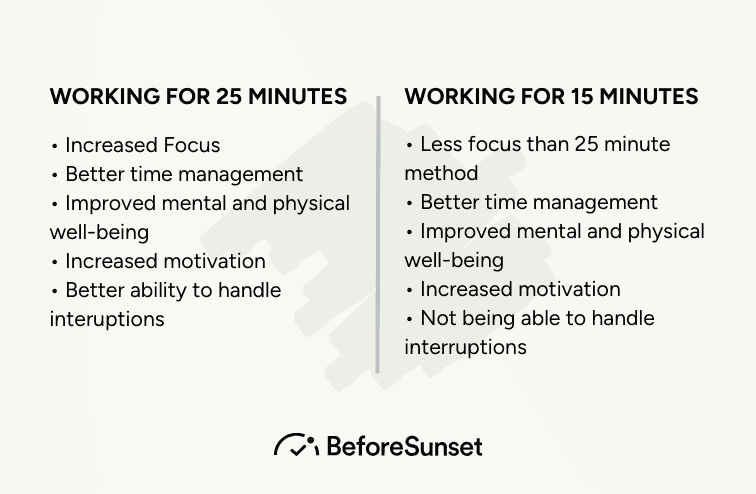
A typical implementation of the 25 minute timer technique would involve prioritizing your tasks for the day, approximating roughly how long you expect them to take, and according to that, delegating them to 25 minute bursts of work.
Here the key is to remember and approach time as a concrete unit with this technique; every interval can be assigned a number to better visualize how your time will be used. With these strategies, it’s always good to simplify the process as much as possible for yourself.
Think of it like an example outlined in a book called “Time Management for Dummies”. Now, visualize it for yourself.
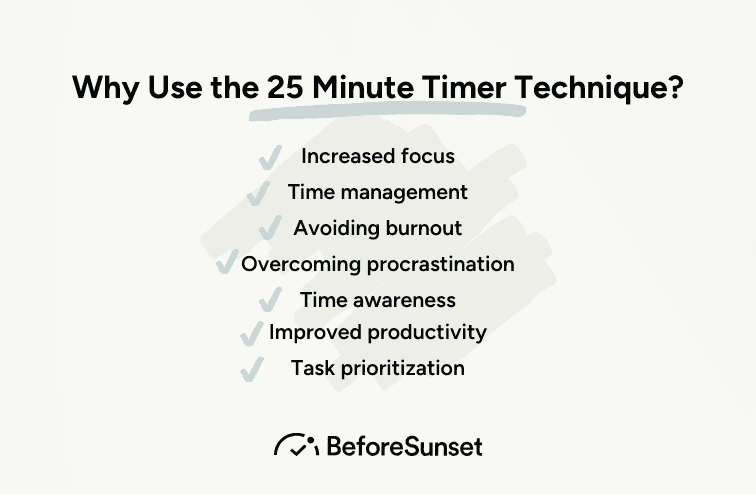
Why Use the 25 Minute Timer Technique?
The 25 minute timer technique is a method of conducting an experiment without the need for controlling many variables. This technique can be used in various different contexts, such as when creating new products, improving user experience and conversion rates, or conducting online surveys.
The 25 minute timer technique is also useful for small businesses that have limited resources to conduct certain experiments with their products and services.
Traditionally, we’re always inclined to wing it till we make it, but if you want to get to the finish line fastest, winging it just won’t cut it. Just ask the turtle and the hare! It turns out that the key to success and long-term productivity relies on taking rests and pacing yourself.
Prolonged work tires our minds out and decreases productivity. So, instead of overworking yourself and ruining your productivity and motivation, try pacing yourself and giving yourself regular rest periods. This way, you’ll give your mind a rest just when it needs it while also catching up with the latest news on Instagram.
This is the exact mindset the 25 minute timer method rests on. Our minds are wired for short-term bursts of productivity but quickly lose productivity when overworked. But when these short bursts are coupled with brief rest periods, you will be able to maintain productivity in the long term with this simple alarm.
Also look forward to what you’re going to accomplish in the next 25 minutes!
And if you successfully finish a task before the 25 minutes have passed, you can always use the remaining time to go over your work and try to find improvements. It’s always good to lean back and review your work from a different perspective.
A fresh set of eyes are always helpful to help enhance your output; it would be even better if those fresh set of eyes were your own!

What is A Simple Timer?
To keep track of how much time has gone, use a basic timer as a tool. It often features buttons or switches to start, stop, and reset the timer as well as a clock or digital display to indicate how much time has elapsed.
Some straightforward timers, like an egg timer, measure the passage of time using a spring or a weighted mechanism. Some timers are electrical and use a quartz crystal to maintain time very precisely.
Basic timers may be used for a variety of purposes, such as keeping track of how long an activity or event lasts or how long it takes to cook food. They are often affordable and simple to use. They are available in a wide range of sizes and forms, from modest portable devices to enormous digital clocks.
So this 25 minute timer counts as a simple timer.
Is Pomodoro Always 25 Minutes?
The Pomodoro Technique is a time management approach that splits work into 25-minute increments interspersed with short breaks. However, the length of the Pomodoro intervals can be adjusted to suit personal preferences and needs.
If a 25-minute break is either too short or too long for them, they may elect to adjust the length of their Pomodoros to accommodate their work style.
For example, although some people prefer 30-minute intervals, others may realize that 20-minute intervals are more helpful for them. The length of the Pomodoro phase should ultimately be determined by how well the strategy works for the individual.
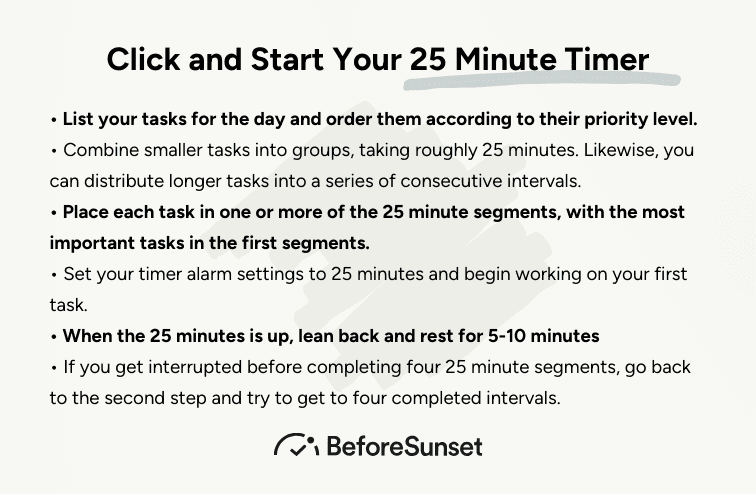
Click and Start Your 25 Minute Timer
The 25 minute timer technique is a method of increasing productivity by taking quick breaks and making sure you are always on track.
The idea behind this technique is to set a timer for five minutes, and then start working on an important task with the goal of getting it done before time runs out. With preset timers, you can start getting things done.
Considering giving the 25 minute timer a shot? Let’s get you started!
Here's The List for You to use the 25 Minute Timer Technique:
1. List your tasks for the day and order them according to their priority level.2. Combine smaller tasks into groups, taking roughly 25 minutes. Likewise, you can distribute longer tasks into a series of consecutive intervals.
3. Place each task in one or more of the 25 minute segments, with the most important tasks in the first segments.
4. Set your timer alarm settings to 25 minutes and begin working on your first task.
5. When the 25 minutes is up, lean back and rest for 5-10 minutes
6. If you get interrupted before completing four 25 minute segments, go back to the second step and try to get to four completed intervals.
7. You did it! The four intervals are complete, and now you can rest for a more extended period. Take around half an hour off to re-energize your mind.
8. Don’t forget to review your work! The best part of this technique is to see how much you accomplish in one day by successfully managing time!
This is only one of the ways you can incorporate the 25 minute timer technique into your work plan, but did you know there are tons more ways you can use this technique to fit your particular work environment or style of working?
25 Minute Timer: Boost Productivity with Short Intervals
Depending on the nature of your work, different work and rest durations may be more practical, so feel free to experiment with varying ratios of time. For example, rather than following the 25:5 minute ratio, maybe you’ll find that 20:4 or 5:1 minute ratios work better for you.
What’s more, if you decide to give our time tracker a shot (did we mention it’s completely free?), you can even get data-driven feedback to help you decide on which ratio works best for you.
At BeforeSunset, we particularly like the traditional 25 minutes followed by 5 minute breaks and use this technique regularly. We find that it’s superbly beneficial and even creates fun competitive games for us.
In addition, as we talked about in Benefits of Time Tracking in Remote Work, happy employees and a warm work atmosphere can stimulate massive boosts in productivity.
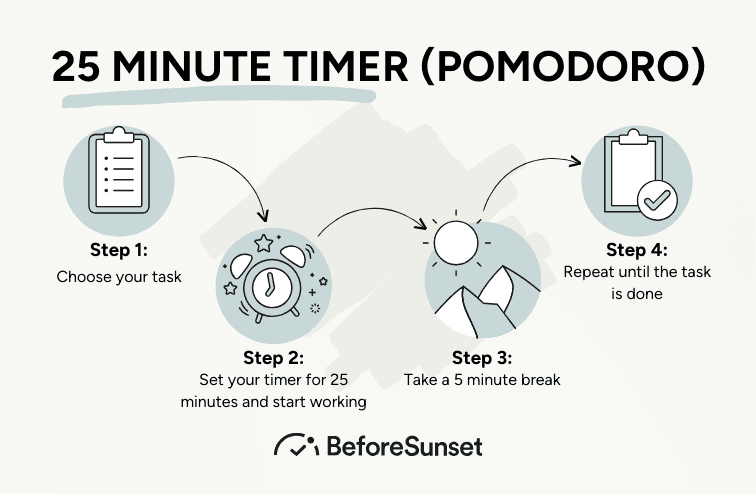
25 Minute Timer Interrupted: What Now?
Interruptions are commonplace when working in dedicated time periods. The dynamism of the workplace rarely leaves room for uninterrupted work.
That’s why a lot of people trying this method for the first time complain about how frustrating it can be to try to keep your head down and focus on your work amid the wave of distractions the workplace throws at you.
When first starting out with the 25-minute timer technique, you might find yourself remembering another important task that you forgot to add or the one email you forgot to reply to. When that’s the case, assess whether you can stick it out and finish your interval, and shift your focus to the other tasks later.
If yes, then go ahead and cross the finish line, but if the task you just remembered simply cannot be delayed, then don’t fret. Just cancel your current interval and start it again later.
And if the time you spent thus far seems wasted, remember, it’s always good to go over your work another time. You just might spot or think of something you never did before!
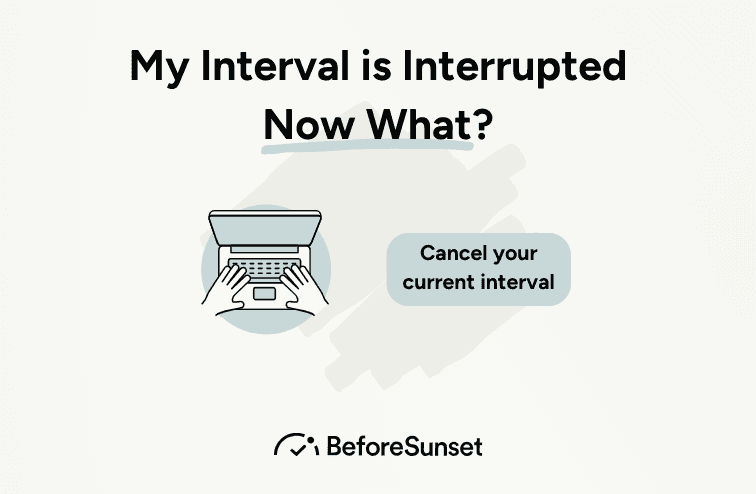
Pros & Cons of The 25 Minute Timer Technique
What Makes it So Good:
Readily Available: You only need a time tracker to begin and you have it. Just scroll up to see the easiest 25 minute timer.
Focus Retention: It wires your brain to avoid unnecessary distractions until the interval is complete. This way you won't get distracted and get your tasks done faster.
More organized: Rather than jumping into the unknown, you know exactly what you’ll be targeting in each interval. Some people have trouble focusing on one task at a time which makes their work more complicated than it should be. To avoid that all you have to do is to select 25 minutes on your timer.
Motivating: One successful interval will encourage you to strive for many more. Seeing yourself succeed will motivate you to do great things.
Sustainable: Regular breaks mean you won’t exhaust yourself. Many people forget to take breaks when working which can lead to burnout. The 25 minute timer reminds you that your body needs some time off.
Why 25 Minutes Timer Technique Might Not Be for You:
- Time constraints: If your workday is too unpredictable, it may be hard to dedicate undivided attention to each interval. Each person works differently so a technique that works for everyone is not possible. Even If the technique you choose is a well-known such as Pomodoro.
-It is hard to return after you take a break from it: 25 minute timer is a great technique but it has one flaw. Once you stop doing it and want to start again it is hard to return to that productive zone.
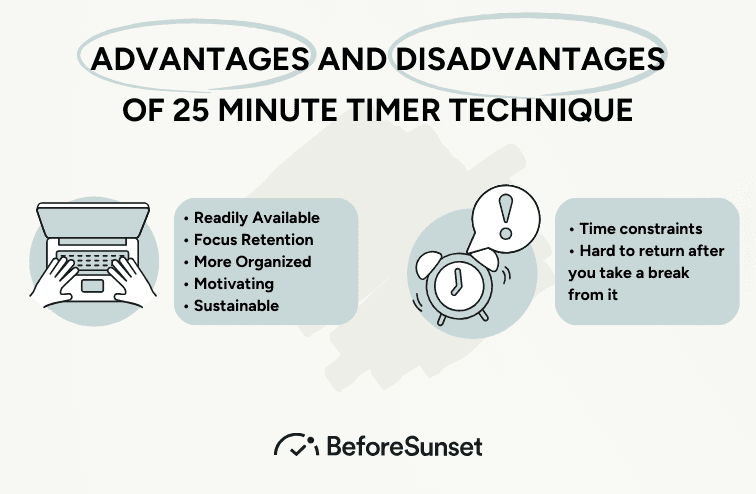
Is Pomodoro Good for ADHD?
The Pomodoro Method offers a disciplined and concentrated approach to work that can assist to eliminate distractions and enhance productivity, making it a useful tool for those with ADHD (Attention Deficit Hyperactivity Disorder).
Procrastination, poor time management, and difficulties finishing work can all be caused by ADHD's tendency to make it difficult to concentrate and stay concentrated for long periods of time. The Pomodoro Method, which divides work into shorter, more manageable intervals and incorporates regular pauses to retain attention and prevent burnout, can be a useful technique for handling these difficulties.
People with ADHD can train their minds to remain on target and avoid distractions by setting a timer for 25 00 minutes and concentrating on one job throughout that period. The technique's regular pauses can also aid in preventing boredom and weariness, which can be problems for those with ADHD.
It's important to keep in mind, though, that because every person with ADHD experiences the illness differently, the Pomodoro Method might not be effective for everyone. It's crucial to remember that your choice shoujld be a specialized strategy for treating ADHD symptoms in collaboration with a healthcare physician or mental health specialist.
How Do You Set A Timer For ADHD?
Setting a timer for ADHD entails choosing an appropriate timing gadget or software and deciding on a certain time limit for the work at hand, usually between 20 and 30 minutes. Create a concentrated environment by getting rid of distractions before setting the timer. When the timer goes off, focus entirely on the job at hand, shifting your attention if necessary.
Even if the work isn't finished when the timer goes off, take a pause to relax and refuel. Utilizing timers consistently throughout the day helps enhance attention and time management. If your daily life is seriously impacted by ADHD symptoms, you should also think about getting professional assistance for individualized advice and treatment alternatives.
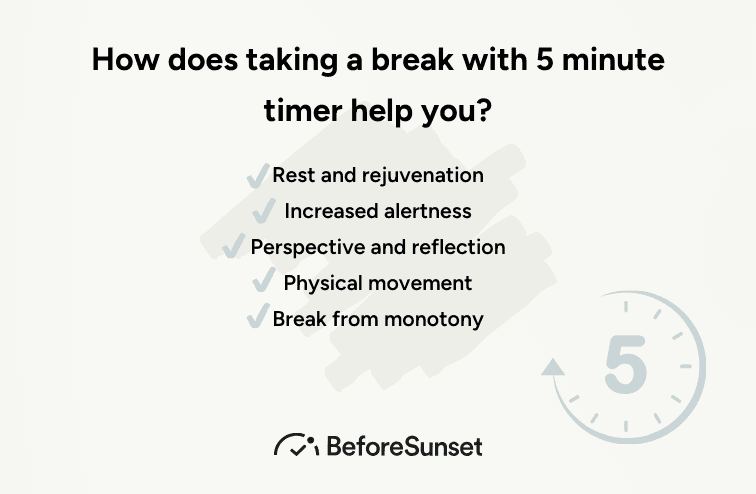
How Does Taking a Break with 5 Minute Timer Help You?
For 25 00 minutes you have given it your all, focused, got some tasks done, and become productive so the next thing you do is take a break. After 25 minutes you slowly start losing your focus, which is your brain's message for you to rest now.
Think of this as a daily cycle, you wake up do the things you need to do and at the end of the day, you go to bed. Why? Because you need to rest in order to be able to function properly tomorrow.
Your brain needs a resting time before it allows you to become productive again. If you don’t allow yourself to rest your productivity will be lowered and you will get fewer things done in a long time.
This is the opposite of what 25 minute timer technique is trying to do. If you are striving to be productive taking a break is a must. Setting a 5 minutes timer is a life changer.
Set timer for 5 minutes and take a break, you earned it!
Pomodoro Tips
There are ways to make 25 timer technique even easier and more effective. The first tip is to get away from the place you work when taking a break. This way your brain becomes aware that you are taking a break also your workstation becomes a place solely for work. It results in getting distracted less when working.
The second tip is to use your break time efficiently. Don't stare at your phone screen for 5 minutes and do something you need to do like use the bathroom, drink water and make a cup of coffee.
Also, remember that 25 timer is just a guideline, you can work 30 minutes If you see fit, or If 5 minute break is not enough for you make it a 10 minute break. The important thing is for you to stay motivated.
Traditional Timers vs. Digital Timers: The Modern Shift
In today's digital age, the use of traditional timers has significantly shifted towards more convenient and versatile digital timers.
Whether you need an online alarm clock for your morning routine or an online countdown timer for focused work sessions, digital timers offer a plethora of features to meet various needs.
One of the key advantages of digital timers is the ability to choose from a range of preselected sounds, ensuring that you wake up or are alerted in a manner that suits you best.
Unlike traditional timers, a digital clock provides precise time management, often integrated with an alarm with snooze options. This snooze feature allows users to set a default snooze time and offers multiple options for snoozes, making it easier to customize based on individual preferences.
For those needing specific countdown functionalities, an online countdown timer with alarms is incredibly useful.
You can set a twenty-five minute timer for productivity techniques like Pomodoro, or use a minute-minute countdown for shorter tasks. Digital timers can also serve as a screen countdown, perfect for presentations or cooking, ensuring you stay on track with a visible time countdown.
The versatility extends to timer clocks and clock apps available on smartphones, which act as a phone clock and a time digital clock.
These apps often include features like a digital clock and an online countdown timer, providing comprehensive time management solutions. Users can easily set alarms with predefined online countdown timer alarms, enhancing productivity and punctuality.
That’s a Wrap!
At BeforeSunset, we know how demanding it can be to finish all your tasks in time. And while the 25-minute timer is a solid technique to use, this doesn’t mean that it’ll be the one for every hourly worker. So, if the 25-minute timer is not the one for you, don’t worry. We got you covered!
Head over to our blog to get a much deeper insight on how a productivity software can do wonders for you so that you can finish your workday before sunset!

